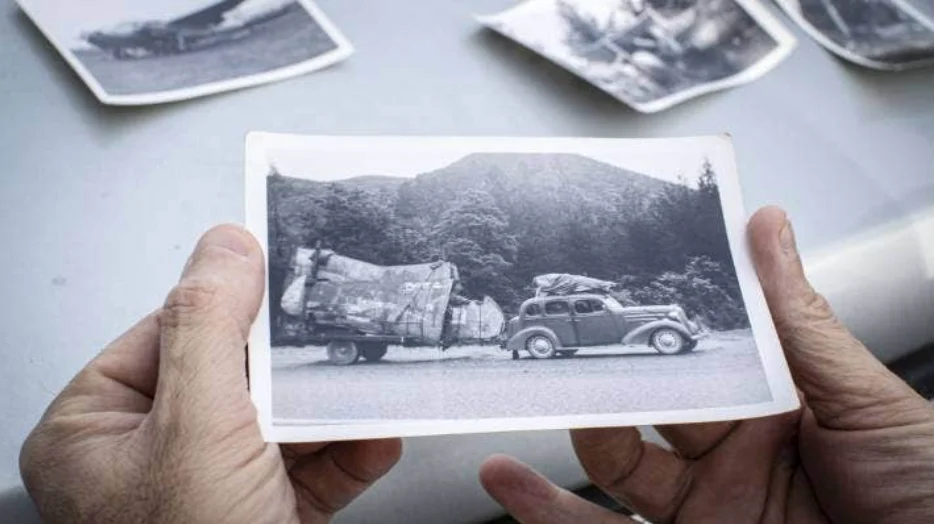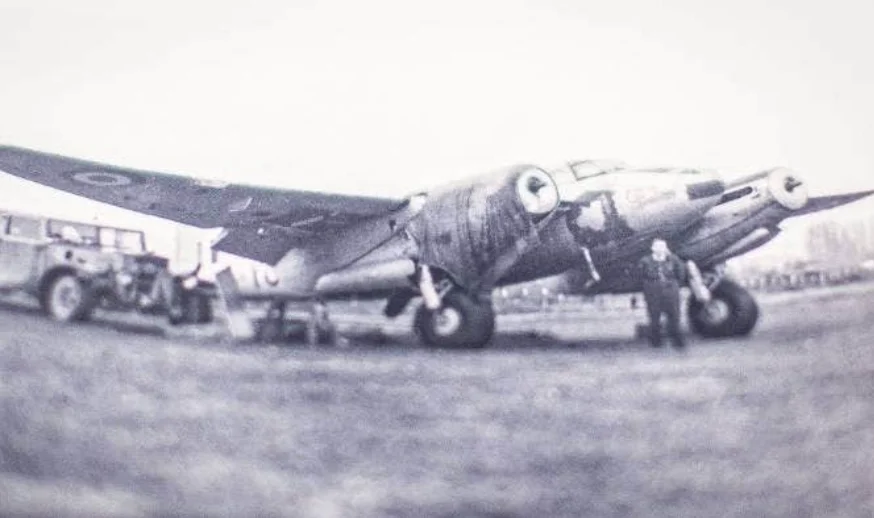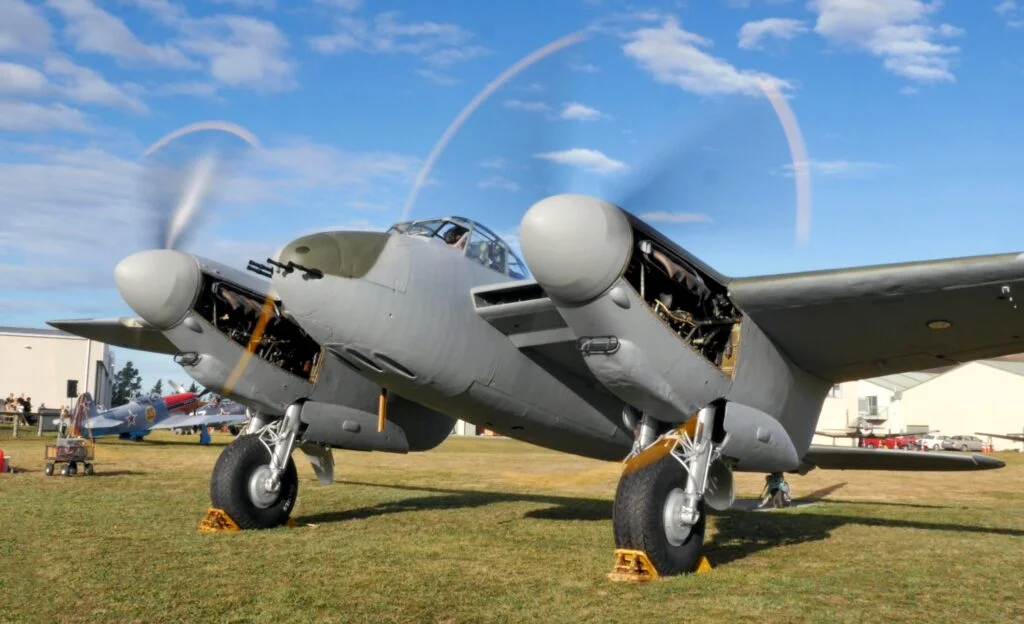
Mosquito NZ2336 Found in a Barn – John Smith Collection
December 18, 2022 No Comments
The de Havilland Mosquito was used by many Allied nations in the Second World War. NZ2336 was operated by the Royal New Zealand Air Force and spent most of her life stored at Woodbourne. She was built as an FB Mk.VI, which was first introduced into service in June 1942. These fighter bomber variants could carry 250 or 500-lb bombs or eight rockets in addition to the four 20 mm Hispano cannons and four .303 machine guns.
This amazing, rare aircraft was sold to a farmer – John Smith in 1955 who kept it on his property in a state of disrepair. She was kept as part of his collection of historic war birds. John, who unfortunately passed away in August 2019, had a treasure trove of military vehicles including a Tiger Moth, P-51D Mustang as well as a pair of P-40 Kittyhawks. Much of his collection has now been given to the Omaka Aviation Heritage Centre, which has put these gems on display.
 John collected aircarft using his car and trailer. Photo credit – Smith Family.
John collected aircarft using his car and trailer. Photo credit – Smith Family.
The Barn Find Mosquito NZ2336
Whilst all of John’s aircraft were noteworthy for one reason or another, the de Havilland Mosquito holds a special place for many. Affectionately given the nickname – the Wooden Wonder by its pilots during the war, this aircraft was a highly capable machine. Fast and deadly, its ability to carry out a wide breadth of missions was key to its success throughout the war.
 NZ2336 was found in a bit of a state. Photo credit – Dave Homewood.
NZ2336 was found in a bit of a state. Photo credit – Dave Homewood.
The Mosquito is now incredibly rare with only 30 or so left and with only three examples still flying.
NZ2336 was originally built for the RAF but arrived too late to see service in the war. It was then purchased and shipped out to New Zealand for use by the RNZAF, flying for only 80 hours (15 of which with the RNZAF) before it was decided the aircraft was surplus to requirement.
However, John Smith wanted this specific example and as with many post-war aircraft it was put up for sale. Delivery would be John’s responsibility, meaning he would need to find some way of transporting the Mosquito to his property.
 A photo of John with NZ2336. Photo credit – Smith Family
A photo of John with NZ2336. Photo credit – Smith Family
This would require dismantling the airframe into small enough parts to be put onto trucks.
Strict deadlines were put on when John had to remove the aircraft and in a hurry he had to cut the fuselage in half and chop off the wings just outside the engine mounts.
Parts of NZ2336 slowly started appearing at his farm in Mapua where he slowly started to reassemble the DH 98. A testament to his ingenuity – he painted the aircraft with a special coating to prevent beetles from eating through the wooden airframe.
 NZ2336 with her Merlin engines running. Photo credit – Omaka Aviation Heritage Centre
NZ2336 with her Merlin engines running. Photo credit – Omaka Aviation Heritage Centre
It was left underneath a metal roof which rested on the aircraft as an attempt to keep to the worst of the weather off her too!
John’s Mosquito NZ2336 has received a full makeover and is completed. After a monumental effort, the Merlin engines will splutter to life! She is one of five in the world with running engines. However, she will not be taking back to the air.
This is due to the Mosquito not meeting the FAA standards for airworthiness. But the question is, with such low hours, could this bird be put back into the air?
The John Smith Collection
John Smith saw the value of aircraft from the Second World War. Whilst many of these incredible machines went to the scrap heap or were sold off for parts, there were very few people who realised their historic importance. He was also keen on flying and enjoyed understanding how they worked.
Whilst not all of these aircraft were in flying condition, having real, physical planes to display in museums for future generations to see was the main goal of passing John’s collection to the Omaka Aviation Heritage Centre.
 Gloria Lyons can be seen here with her mission markings.
Gloria Lyons can be seen here with her mission markings.
Some of his airframes were truly impressive, such as the pair of Curtiss Kittyhawks NZ3220 and NZ3043. The P-40 Gloria Lyons is complete and even in her wartime paint with mission markings, now sits as one of the most special aircraft at the heritage centre.
NZ3220 has 55 bombs painted on the side of the aircraft to represent the number of bombing/strike missions that she had been on. Just before the end of the Second World War, the P-40 was transferred to a training squadron where she taught hundreds of pilots the skill to go on to fly the F4U. Like many of John Smith’s aircraft, this one was destined for the scrap heap. He purchased Gloria Lyons in the 60s with just fuselage and wings.
Other aircraft in his collection included a Lockheed Hudson light bomber NZ2049, P-51D Mustang NZ2423, and even remains of a de Havilland Vampire as well as several DH.98 Mosquitos.
After John’s passing much of his giant collection was passed onto the Omaka Aviation Heritage Centre, based in Omaka, Blenheim, for display. Huge amounts of work have been put into restoring these aircraft to the highest possible standards.
His P-51D was in good enough condition to be restored and put back into the sky! However, not all of the others are able to return to the skies. The Lockheed Hudson has been left relatively untouched but will give visitors to the centre a feeling of what a plane crash would look like.
 John’s Lockheed Hudson is also on display at the centre.
John’s Lockheed Hudson is also on display at the centre.
News
The Hanging Temple: China’s 1,500-Year-Old Cliffside Marvel of Faith and Engineering
The Hanging Temple: China’s 1,500-Year-Old Cliffside Marvel of Faith and Engineering Perched precariously on the cliffs of Mount Heng in Shanxi Province, China, the Hanging Temple, also known as Xuankong Temple, Hengshan Hanging Temple, or Hanging Monastery, is an architectural…
The Willendorf Venus: A 30,000-Year-Old Masterpiece Reveals Astonishing Secrets
The Willendorf Venus: A 30,000-Year-Old Masterpiece Reveals Astonishing Secrets The “Willendorf Venus” stands as one of the most revered archaeological treasures from the Upper Paleolithic era. Discovered in 1908 by scientist Johann Veran near Willendorf, Austria, this small yet profound…
Unveiling the Maya: Hallucinogens and Rituals Beneath the Yucatán Ball Courts
Unveiling the Maya: Hallucinogens and Rituals Beneath the Yucatán Ball Courts New archaeological research has uncovered intriguing insights into the ritual practices of the ancient Maya civilization. The focus of this study is a ceremonial offering found beneath the sediment…
Uncovering the Oldest Agricultural Machine: The Threshing Sledge’s Neolithic Origins
Uncovering the Oldest Agricultural Machine: The Threshing Sledge’s Neolithic Origins The history of agricultural innovation is a fascinating journey that spans thousands of years, and one of the earliest known agricultural machines is the threshing sledge. Recently, a groundbreaking study…
Nara’s Ancient Sword: A 1,600-Year-Old Protector Against Evil Spirits
Nara’s Ancient Sword: A 1,600-Year-Old Protector Against Evil Spirits In a remarkable discovery that has captured the attention of archaeologists and historians alike, a 7.5-foot-long iron sword was unearthed from a 1,600-year-old burial mound in Nara, Japan. This oversized weapon,…
The Inflatable Plane, Dropped Behind the Lines for Downed Pilots
Experimental The Inflatable Plane, Dropped Behind the Lines for Downed Pilots The Inflatoplane from Goodyear was an unconventional aircraft developed by the Goodyear Aircraft Company, a branch of the renowned Goodyear Tire and Rubber Company, also famed for the Goodyear…
End of content
No more pages to load











